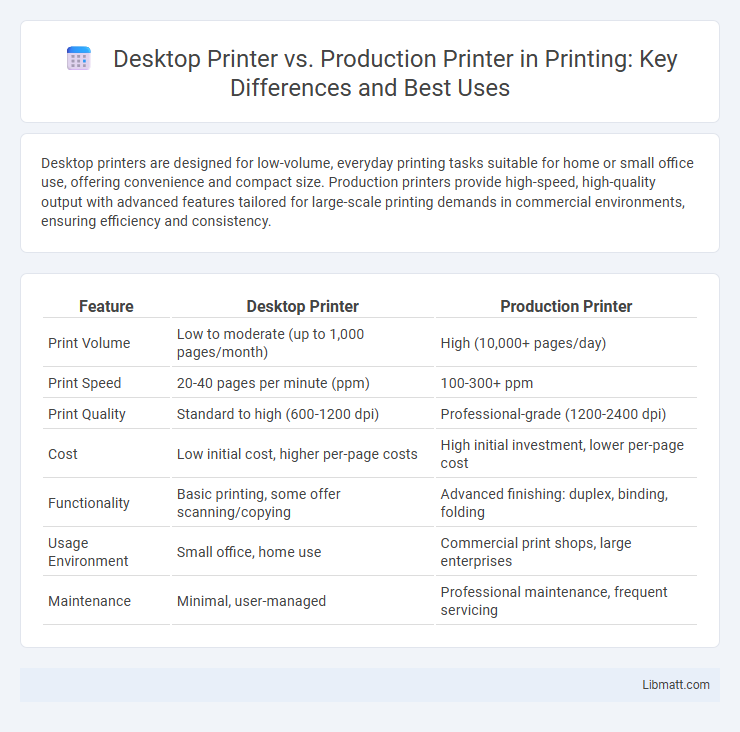Desktop printers are designed for low-volume, everyday printing tasks suitable for home or small office use, offering convenience and compact size. Production printers provide high-speed, high-quality output with advanced features tailored for large-scale printing demands in commercial environments, ensuring efficiency and consistency.
Table of Comparison
| Feature | Desktop Printer | Production Printer |
|---|---|---|
| Print Volume | Low to moderate (up to 1,000 pages/month) | High (10,000+ pages/day) |
| Print Speed | 20-40 pages per minute (ppm) | 100-300+ ppm |
| Print Quality | Standard to high (600-1200 dpi) | Professional-grade (1200-2400 dpi) |
| Cost | Low initial cost, higher per-page costs | High initial investment, lower per-page cost |
| Functionality | Basic printing, some offer scanning/copying | Advanced finishing: duplex, binding, folding |
| Usage Environment | Small office, home use | Commercial print shops, large enterprises |
| Maintenance | Minimal, user-managed | Professional maintenance, frequent servicing |
Overview of Desktop Printers and Production Printers
Desktop printers are compact devices designed for low-volume printing tasks, ideal for home offices or small businesses requiring quick and cost-effective document output. Production printers, also known as high-volume or industrial printers, offer superior speed, advanced color management, and robust durability, catering to large-scale printing needs in commercial printing environments. These printers utilize advanced technologies for consistent, high-quality prints on a wide range of media types, supporting mass print jobs with enhanced workflow integration.
Key Differences Between Desktop and Production Printers
Desktop printers are compact devices designed primarily for low-volume printing tasks, offering convenience and affordability suitable for home or small office use. Production printers, also known as high-volume or industrial printers, deliver rapid print speeds, superior image quality, and advanced finishing options critical for large-scale commercial printing operations. The key differences lie in their printing capacity, speed, cost per page, and maintenance complexity, with production printers optimized for continuous, high-quality output under demanding workloads.
Print Speed and Volume Capabilities
Desktop printers typically offer print speeds ranging from 15 to 30 pages per minute, suitable for low to moderate volume tasks in home or small office settings. Production printers, designed for high-volume environments, can achieve speeds exceeding 100 pages per minute, enabling continuous, large-scale printing without frequent interruptions. Your choice should align with your print volume needs, as production printers handle thousands of pages daily, whereas desktop printers are ideal for occasional or moderate use.
Print Quality and Resolution Comparison
Desktop printers typically deliver print resolutions ranging from 600 to 1200 dpi, suitable for everyday documents and basic photo printing with moderate color accuracy. Production printers boast significantly higher resolutions, often exceeding 2400 dpi, enabling ultra-fine detail and vibrant color fidelity essential for professional-grade graphics, marketing materials, and high-volume print runs. The advanced print heads and inks in production printers ensure consistent, sharp output with superior color depth compared to standard desktop models.
Cost Analysis: Initial Investment and Operational Costs
Desktop printers typically require a lower initial investment, making them suitable for small offices or personal use, while production printers demand a higher upfront cost due to advanced features and greater capacity. Operational costs for desktop printers are generally lower but can escalate with frequent use and higher volume printing, whereas production printers offer cost-efficiency at scale with reduced per-page expenses. Your choice should balance initial budget constraints against long-term printing volume to optimize overall cost-effectiveness.
Space Requirements and Installation Needs
Desktop printers require minimal space and can easily fit on a desk, making them ideal for small offices or personal use with straightforward installation. Production printers demand significantly more room due to their larger size and complex components, often necessitating dedicated areas with proper ventilation and power setups. Your choice should consider available space and infrastructure to ensure efficient operation and maintenance.
Maintenance and Support Considerations
Desktop printers typically require minimal maintenance, with simple tasks like replacing ink cartridges and occasional printhead cleaning, making them suitable for small office environments. Production printers demand rigorous maintenance schedules including regular calibration, part replacements, and firmware updates to ensure optimal performance and reduce downtime in high-volume printing settings. Support for production printers often involves dedicated technical teams and service contracts, while desktop printers rely on basic user troubleshooting and manufacturer warranties.
Suitable Applications for Desktop vs. Production Printers
Desktop printers are ideal for small-scale, low-volume tasks such as home offices, personal documents, and occasional printing needs due to their compact size and affordability. Production printers excel in high-volume, professional environments like commercial printing, marketing materials, and packaging because they deliver fast output, superior quality, and advanced features. Your choice depends on whether you prioritize convenience and cost for everyday use or durability and efficiency for large production runs.
Scalability and Workflow Integration
Desktop printers offer limited scalability and are best suited for low-volume, individual tasks, whereas production printers are designed to handle high-volume output with consistent speed and quality. Production printers integrate seamlessly into complex workflows using advanced software solutions, enabling automation, job tracking, and color management to optimize efficiency. Your choice depends on the need for scalability and the ability to integrate printing processes into larger business operations.
Choosing the Right Printer for Your Business Needs
Desktop printers are ideal for small businesses requiring low to moderate print volumes with a focus on affordability and compact design, while production printers cater to high-volume demands with advanced features like faster print speeds, superior image quality, and durable components suited for large-scale commercial printing. Businesses must assess factors such as print volume, budget, space constraints, and the need for specialized printing capabilities like color accuracy or finishing options. Selecting the right printer ensures operational efficiency, cost-effectiveness, and support for growth in business printing requirements.
desktop printer vs production printer Infographic

 libmatt.com
libmatt.com